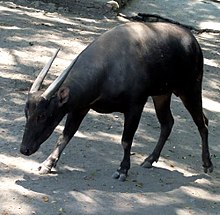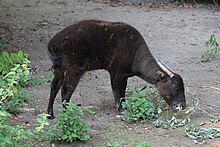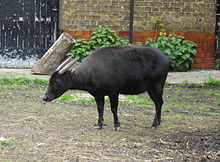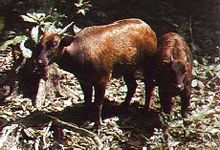Anoa
- This article refers to the animal. For the Indonesian-made military vehicle, see Anoa (armoured personnel carrier).
| Anoa | |
|---|---|
 | |
| Lowland anoa (B. desdrepassicornis) at the Surabaya Zoo, Surabaya, East Java, Indonesia | |
 | |
| Mountain anoa (B. quarlesi) at the Krefeld Zoo, Krefeld, Germany | |
Conservation status | |
 Endangered (IUCN 3.1)[1][2] | |
Scientific classification | |
| Kingdom: | Animalia |
| Phylum: | Chordata |
| Class: | Mammalia |
| Order: | Artiodactyla |
| Family: | Bovidae |
| Subfamily: | Bovinae |
| Genus: | Bubalus |
| Species: | B. depressicornis |
Binomial name | |
Bubalus depressicornis (H. Smith, 1827) | |
Bubalus quarlesi (Ouwens, 1910) | |
Anoa, also known as midget buffalo and sapiutan, are a subgenus of Bubalus comprising two species endemic to the island of Sulawesi in Indonesia: the mountain anoa (Bubalus quarlesi) and the lowland anoa (Bubalus depressicornis). Both live in undisturbed rainforest, and are essentially miniature water buffalo. They are similar in appearance to a deer, weighing 150–300 kg (330–660 lb).
Both species of anoa have been classified as endangered since the 1960s, and the population continues to decrease. Fewer than 5000 animals of each species likely remain. Reasons for their decline include hunting for hide, horns, and meat by the local peoples and loss of habitat due to the advancement of settlement. Currently, hunting is the more serious factor in most areas.
After a study of the skulls of many Anoa it was shown that there was hybridizing and interbreeding between the two. It was questioned as to whether the two species were actually different due to mixing of the two in many different areas as well as some interbreeding. After analyzing the DNA of the two it was proven that they are in fact different species.
Contents
1 Lowland anoa
2 Mountain anoa
3 Habitat
4 Morphology
5 Conservation
6 References
7 External links
Lowland anoa

Lowland anoa
The lowland anoa (Bubalus depressicornis) is a small bovid, standing barely over 90 cm (35 in) at the shoulder. They are also known as anoa de Ilanura or anoa des plaines. It is most closely allied to the larger Asiatic buffaloes, showing the same reversal of the direction of the hair on their backs. The horns are peculiar for their upright direction and comparative straightness, although they have the same triangular section as in other buffaloes. White spots are sometimes present below the eyes, and there may be white markings on the legs and back; the absence or presence of these white markings may be indicative of distinct races. The horns of the cows are very small. The nearest allies of the anoa appear to be certain extinct buffaloes, the remains of which are found in the Siwalik Hills of northern India. In habits, the animal appears to resemble the Indian buffalo.[3] It is usually solitary, living in lowland forests and wetlands, browsing on plants and understory.
Mountain anoa

Mountain anoa
Mountain anoa (Bubalus quarlesi) are also known as anoa de montana, anoa de Quarle, anoa des montagnes, anoa pegunungan, and Quarle's anoa. Standing at 70 cm (28 in) at the shoulder, it is even smaller than the lowland anoa and the smallest of all wild cattle. They also have longer, woolier hair that moults every February to April, showing faint spots on the head, neck, and limbs.[4]
Both are found on the island of Sulawesi and the nearby island of Buton in Indonesia. They apparently live singly or in pairs, rather than in herds like most cattle, except when the cows are about to give birth. Little is known about their life history as well. However in captive individuals they have a life expectancy of 20-30 years. The Anoa take 2-3 years before they reach sexual maturity and have one calf a year and have very rarely been seen to have more.
Habitat
Both the Lowland Anoa Bubalus depressicornis and the Mountain Anoa Bubalus quarlesi are endemic to the islands of Sulawesi in Indonesia. Sulawesi is a unique area due to the fact that roughly 61% of the species found there are endemic species including the Anoa.
The key difference between the two species is the areas of habitat that is utilized on the islands. The Mountain Anoa is found at higher elevations than its counterpart and is found in the forested mountainous regions. The Lowland Anoa spends its time in the lower elevation areas and is also found in core habitat of forested area. The habitat needs of both species can have some overlap and often times the two species are found in the same areas. The key factor to where they are found is core forested habitat away from humans.
Morphology
The Anoa have many physical characteristics of bovine relatives and are considered to be most closely related to the Asian Water Buffalo which was confirmed through DNA analysis. However some scientists believe they may be more closely related to the Asiatic Antelope. All Anoa vary in appearance a good amount but have the same standard characters.
The two species diverged due to a difference in elevation and a slight change in habitat from the latter, but their physical characteristics remain similar. The Anoa is the smallest of the wild cattle species. When Anoa are born they have a set of thick wooly fur that comes in many color variations from yellow to brown. In adults the fur is typically a brown or black and males tend to have darker variations. Hair thickness varies slightly between the two species based on elevation and distribution. In both Species of Anoa horns are present both males and females and are typically straight protuberances. Another defining characteristic of the Anoa is an extremely thick hide underneath the thick fur.
Conservation
The Anoa are endemic to the region of Sulawesi and are currently experiencing large declines in their populations. Knowledge of their decline has only recently been documented however and the villages and villagers lack the knowledge of how to help maintain or increase populations.
The leading cause of their population decline is in fact hunting by the local villagers and not having restrictions or proper management strategies.[citation needed] The one benefit is that villagers are open to communication with researchers on their harvests and hunting practices. The second leading cause of population decline is habitat loss and in the region of Tangkoko the Anoa are actually extirpated.
Logging is a large issue due to the fact that both species prefer core forested habitat that is far away from humans and the influences that come with them. By logging humans create much more fragmented habitat and therefore a decrease in the area where the Anoa can breed and live. This habitat fragmentation also alters the natural mixing of populations of Anoa and may lead to a loss in genetic diversity of the two species and over time could also lead to their decline.
References
^ Semiadi, G.; Mannullang, B.; Burton, J.; Schreiber, A.; Mustari, A.H.; IUCN SSC Asian Wild Cattle Specialist Group (2008). "Bubalus depressicornis". IUCN Red List of Threatened Species. Version 2015.2. International Union for Conservation of Nature. Retrieved 2015-07-19..mw-parser-output cite.citation{font-style:inherit}.mw-parser-output q{quotes:"""""""'""'"}.mw-parser-output code.cs1-code{color:inherit;background:inherit;border:inherit;padding:inherit}.mw-parser-output .cs1-lock-free a{background:url("//upload.wikimedia.org/wikipedia/commons/thumb/6/65/Lock-green.svg/9px-Lock-green.svg.png")no-repeat;background-position:right .1em center}.mw-parser-output .cs1-lock-limited a,.mw-parser-output .cs1-lock-registration a{background:url("//upload.wikimedia.org/wikipedia/commons/thumb/d/d6/Lock-gray-alt-2.svg/9px-Lock-gray-alt-2.svg.png")no-repeat;background-position:right .1em center}.mw-parser-output .cs1-lock-subscription a{background:url("//upload.wikimedia.org/wikipedia/commons/thumb/a/aa/Lock-red-alt-2.svg/9px-Lock-red-alt-2.svg.png")no-repeat;background-position:right .1em center}.mw-parser-output .cs1-subscription,.mw-parser-output .cs1-registration{color:#555}.mw-parser-output .cs1-subscription span,.mw-parser-output .cs1-registration span{border-bottom:1px dotted;cursor:help}.mw-parser-output .cs1-hidden-error{display:none;font-size:100%}.mw-parser-output .cs1-visible-error{font-size:100%}.mw-parser-output .cs1-subscription,.mw-parser-output .cs1-registration,.mw-parser-output .cs1-format{font-size:95%}.mw-parser-output .cs1-kern-left,.mw-parser-output .cs1-kern-wl-left{padding-left:0.2em}.mw-parser-output .cs1-kern-right,.mw-parser-output .cs1-kern-wl-right{padding-right:0.2em}
^ Semiadi, G.; Burton, J.; Schreiber, A.; Mustari, A.H. (2008). "Bubalus quarlesi". IUCN Red List of Threatened Species. Version 2015.2. International Union for Conservation of Nature. Retrieved 2015-07-19.
^ One or more of the preceding sentences incorporates text from a publication now in the public domain: Chisholm, Hugh, ed. (1911). "Anoa". Encyclopædia Britannica. 2 (11th ed.). Cambridge University Press. p. 79.
One or more of the preceding sentences incorporates text from a publication now in the public domain: Chisholm, Hugh, ed. (1911). "Anoa". Encyclopædia Britannica. 2 (11th ed.). Cambridge University Press. p. 79.
^ "Mountain anoa videos, photos and facts – Bubalus quarlesi – ARKive". ARKive.
External links
| Wikimedia Commons has media related to Bubalus depressicornis. |
| Wikimedia Commons has media related to Bubalus quarlesi. |
DIET COMPOSITION OF ANOA (Buballus sp.) STUDIED USING DIRECT OBSERVATION AND DUNG ANALYSIS METHOD IN THEIR HABITAT from https://ejournal.undip.ac.id/index.php/jitaa/article/view/7608/6259
Pujaningsih, R.i., et al. “DIET COMPOSITION OF ANOA (Buballus Sp.) STUDIED USING DIRECT OBSERVATION AND DUNG ANALYSIS METHOD IN THEIR HABITAT.” Journal of the Indonesian Tropical Animal Agriculture, vol. 34, no. 3, 2009, doi:10.14710/jitaa.34.3.223-228.
Lowland Anoa bubalus depressicornis Smith from wildcattleconservation.org